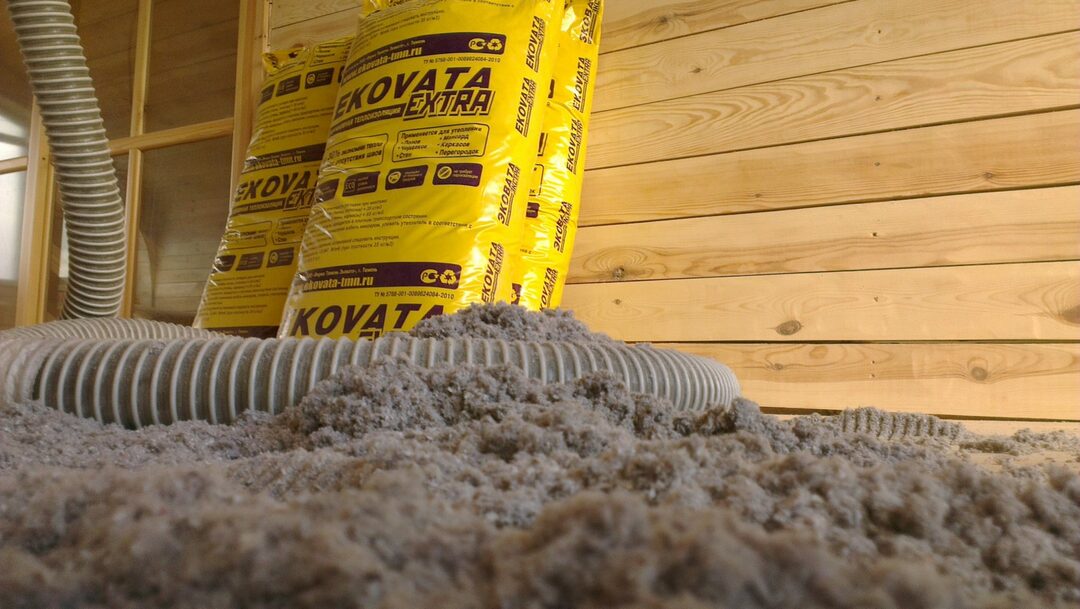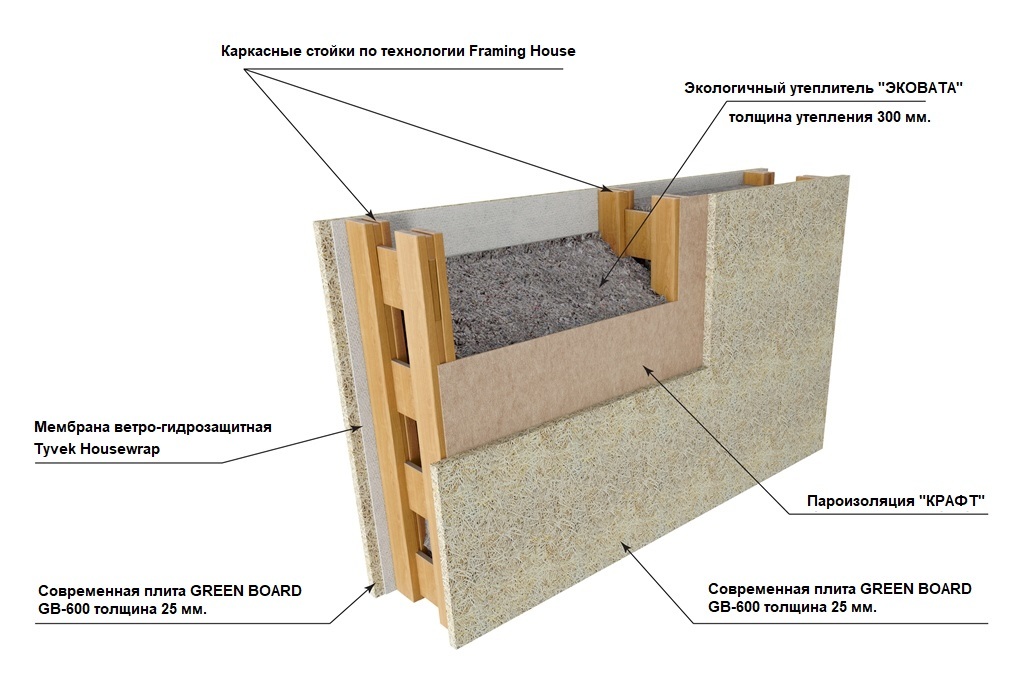The use of the correct and high-quality insulation for housing allows you to permanently solve the problem with the temperature regime in the premises. Today the construction market offers a wide range of materials for floor, wall and ceiling insulation.
Ecowool is a type of cellulose insulation that is becoming more and more popular among the modern consumer. It is safe for humans and the environment, can be used for sound insulation, and is affordable. The ecowool rating is based on its advantages, price and manufacturer. And we have selected the best products for you in accordance with these indicators.
Composition, release form and technical characteristics of the material
Ekovata got its name for a reason. It consists of 81% cellulose, an organic plant compound that is extracted from wood. Recyclable materials are used for the production of ecowool, as well as recycled paper. The remaining 19% of the composition are natural antiseptics (boric acid derivatives) and antiperenes (sodium tetraborate, better known as borax).
These components are non-toxic, they protect the insulation from rodents, insects, and fire. Ecowool looks like a loose, fibrous filler of dark gray color. It crumbles easily and in appearance really resembles the structure of ordinary cotton wool. Sometimes, among the fibers, you can even see small scraps of paper that was used in the production.
On a note! The insulation keeps its shape well and does not get dusty, so you can not be afraid of its raining out of the holes when insulating the frame of the room.
The enterprises for the production of this material are mainly of two types. It can be a fully automated line with high productivity or a budget line with no some stages in the production process (reduced tetraborate content, paper crushing slightly lower in quality). This affects the rating of ecowool manufacturers. Ecowool is produced in briquettes or hermetically sealed bags, as it is a free-flowing material.

Ecowool technical characteristics:
- Low thermal conductivity (thermal conductivity coefficient is 0.038 W / m * K);
- High heat capacity (the coefficient of heat capacity of ecowool is 3 times higher than the indicators of other heaters for this parameter);
- Low air permeability (due to the dense and fibrous structure of the material, the density coefficient is 35-75 kg / m3);
- High capillary activity (internal moisture transfer works according to two mechanisms - diffuse and capillary, and condensation does not form in a room insulated with ecowool, indicator 0.3 mg / m * h * Pa);
- Fire resistance (successfully resists fire, low-combustible insulation class B1 - hardly flammable);
- Environmental friendliness (there are only three components, the main of which is paper, which is completely safe for health);
- Ability to absorb high and medium frequencies (can be used for soundproofing works);
- Shrinkage of the material (on horizontal and vertical surfaces it is applied in different ways, but it is stable during installation and further operation).
These characteristics may differ from manufacturer to manufacturer, depending on the design of the production lines, as well as on the quality of the initial raw materials. Therefore, we recommend that you familiarize yourself with the TOP-rating of the best manufacturers and figure out which ecowool is better.
Rating of the best ecowool manufacturers
The rating includes the leading brands that produce ecowool according to the opinion of consumers and experts in the field of thermal insulation.
GreenWool
The ecowool rating is headed by GreenWool. It is the largest manufacturer of cellulose insulation; it has been on the consumer market since 1983. The company operates on the Finnish Macron line. Ecowool of this brand corresponds to the initial quality even after many years of operation, retains additives and does not lose its shape.
ECOCELL
Insulation with a low coefficient of dust formation. Tops the rating of ecowool manufacturers among consumers in America. The cellulose content in the total mass is slightly less (about 70%), but among the additional additives it is necessary to highlight the presence of a fungicide. It prevents contamination by microorganisms and molds.
Unisol
One of the Ukrainian manufacturers of high quality ecowool. Its material is environmentally friendly, it insulates heat well. Contains fire retardants (borax), which are good at resisting fire when ignited.
IGLOO
Among the manufacturers of ecowool, IGLOO is rated as a reliable material. This is a well-known Canadian insulation with a high cellulose content in an amount up to 85% of the total composition. The remaining 15% are natural ingredients that quickly decompose in the natural environment. This material is one of the safest, since it does not contain ammonium sulfate. At the same time, the advantages include high sound absorption and low thermal conductivity.
Isofiber
Norwegian version of ecowool, which is characterized by a high degree of heat capacity. When vaporized between wall structures, it retains moisture in the upper layers of the insulation, which does not affect its basic properties.
EkoVilla
This is a Finnish manufacturer's insulation that meets all the main positive characteristics of a high-quality thermal insulation material. Ecowool from "Ekovita" is environmentally friendly, it is made from newsprint and corrugated cardboard. The products are widely distributed in the Russian and foreign markets.
Isofloc
Ecowool Isofloc is produced in Germany. This material is in demand when insulating houses in harsh climatic conditions. The properties of the products are comparable to those of wood: thanks to the material, the rooms retain heat without forming condensation due to their high hygroscopicity. All products are certified in accordance with international standards, which additionally inspires confidence among consumers and confirms high quality ..
Nanowata
These products are popular with experienced builders. The Russian manufacturer Nanovata sells a new generation of insulation. It combines high quality and low price. The products have certificates of compliance with global standards and environmental standards.
Steico
Eco-friendly blown / loose insulation based on primary wood fibers. The advantages of the product are material homogeneity, fire resistance and no shrinkage when filling voids.
Termex
The Termex brand is deservedly included in the ecowool rating by manufacturer. This is the Finnish equivalent of ecowool, which creates an integral layer and, thereby, effectively insulates the heat in the room. The products have a predominantly natural composition: natural clay plays the role of a fire retardant in it.
Equator
The ecowool rating is completed by Equator, which is a brand of a large manufacturer. The country of its release is Russia; this brand has been present on the market since 2007. The products are manufactured on fully automated equipment. As a result, it meets all the technical requirements for a high-quality heat insulator.
One of the advantages of the material is the absence of large particles of newspapers in the bulk of the insulation. It is also worth noting the presence of antiseptics and fire retardants in the composition.
How to choose the right ecowool
When choosing ecowool, you should pay attention to several basic parameters. Any consumer is interested in the quality of the material produced, so you need to start evaluating already in the store.
The packaging should not be broken in order to be able to analyze the appearance of the insulation. There should be no fine-grained sediment at the bottom, since the opposite indicates a violation of storage conditions or incorrect production technology.
In the composition, it should be noted the presence of fire retardants: if they are not there, ecowool can ignite from an accidental spark. The color of a quality product is gray or dark gray, uniform and free of inclusions. Shades of a different color may indicate a manufacturer's dishonesty and / or poor raw materials.

Insulation technology for frame construction: advice from experts in the field of construction
Well, now let's briefly consider the technology of warming the frame structure using ecowool as a heat-insulating material.
Blowing equipment
The process of applying ecowool requires the use of special equipment. These automatic installations may differ in technical characteristics, power, installation speed. They are divided into three categories according to the method of application:
The dry method involves the use of blowing machines with or without a turner, as well as the ability to adjust the blowing force. The equipment can be provided with a remote control (Accu1, X-Floc devices), which is very convenient.
Ecowool is applied in a wet way using blow molding machines that provide preliminary moistening of the material and its subsequent application in this form (CoolMachines, Zellofant M95).
Mixed installations are suitable for application by both dry and wet methods (for example, the professional installation UralEkoMaster-700-mini).
Wet home insulation method
This method of bookmarking is popular when installing insulation in vertical structures. With the help of a special construction apparatus, pre-moistened ecowool is applied under pressure in layers to the floors. Such application excludes the appearance of shrinkage of the heat-insulating material, but it also has disadvantages: after work, you cannot immediately start finishing, since ecowool needs time to dry ecowool (about 1-5 days).
"Dry" filling of the wall space
This method combines manual work and the use of special equipment. First, the ecowool is removed from the briquette and whipped to reduce the compaction that appears during transportation. Then it is placed in the space of the lathing and rammed by hand until it reaches the required density. Instead of ramming, the second method is used: the method of automatic blowing with a special apparatus.
Manual backfilling of floors
It is recommended to fill in ecowool manually only when insulating small rooms. It is advisable for thermal insulation of horizontal surfaces: floors, storey, attic floors, etc. It is laborious and time consuming to insulate a large house with this method, it is better to use the services of specialized companies.

Is it possible to make ecowool with your own hands?
The technology for making ecowool is quite simple, because the main operations are shredding paper to the state of individual fibers and mixing with them additives - tetraborates and anti-perenes. To make ecowool with your own hands, you need to have the required amount of paper and a shredder.
In automated production, special shredding machines and installations are used. At home, there is a way when resourceful craftsmen use old-style washing machines that have been preserved on the farm. At the same time, they are supplemented with additional knives, and the grinding process is started.
The main disadvantage of this method is that it takes a lot of time. It is also worth noting the need for mandatory processing of the future insulation before using with chemical components.
Reviews of the owners of houses insulated with ecowool
Homeowners who insulated with ecowool generally speak out positively about their experience of using it. The following benefits voiced by consumers can be cited as confirmation:
- Adheres well to the wall during installation;
- Easily flattens through the sheathing until dry;
- Leaves minimal spaces in plugged cavities;
- Good soundproofing of walls and ceilings;
- Provides minimal costs for leveling wall surfaces;
- Excellent soundproofing of communication niches;
- Differs in low concentration and safety during long-term use.
Disadvantages of ecowool that users paid attention to:
- Requires strict adherence to storage conditions to protect against dampness;
- For imported materials, the price for briquettes with ecowool is higher, so foreign ecowool manufacturers are losing their rating;
- When installing, requires the use of respirators to protect against dust exposure;
- Assumes the need to rent / purchase special equipment;
- Can cause allergies to so-called "library" dust.
Conclusion
Ecowool is a modern practical insulation, which is convenient to use in the construction of frame houses and insulation of various structures. Therefore, among other things, it deservedly occupies one of the first places in the market of heat-insulating materials.
Ecowool prevents mold and mildew from attacking wooden walls and ceilings, extending their service life. In the segment of environmentally friendly heaters, it has the least drawbacks in terms of the content of chemical impurities. High heat-preserving and noise-insulating indicators due to the homogeneity of the material make ecowool preferable for warming premises, well, our rating of ecowool will help to determine the choice.



